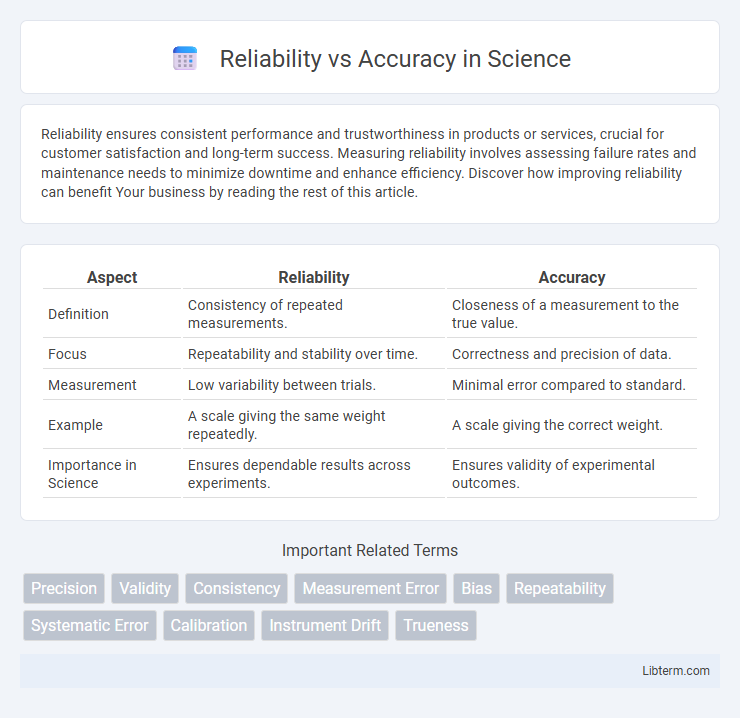Reliability ensures consistent performance and trustworthiness in products or services, crucial for customer satisfaction and long-term success. Measuring reliability involves assessing failure rates and maintenance needs to minimize downtime and enhance efficiency. Discover how improving reliability can benefit Your business by reading the rest of this article.
Table of Comparison
| Aspect | Reliability | Accuracy |
|---|---|---|
| Definition | Consistency of repeated measurements. | Closeness of a measurement to the true value. |
| Focus | Repeatability and stability over time. | Correctness and precision of data. |
| Measurement | Low variability between trials. | Minimal error compared to standard. |
| Example | A scale giving the same weight repeatedly. | A scale giving the correct weight. |
| Importance in Science | Ensures dependable results across experiments. | Ensures validity of experimental outcomes. |
Introduction to Reliability and Accuracy
Reliability refers to the consistency of measurement results when repeated under identical conditions, ensuring dependable data over time. Accuracy measures how close a result or measurement is to the true or accepted value, reflecting the correctness of the data. Both reliability and accuracy are crucial in data analysis and scientific experiments to validate findings and ensure meaningful conclusions.
Defining Reliability: Consistency in Measurement
Reliability refers to the consistency and stability of measurement results over repeated trials, ensuring that the data collected is dependable and replicable. High reliability indicates that the measurement process produces similar outcomes under consistent conditions, minimizing random errors or fluctuations. Unlike accuracy, which measures how close results are to the true value, reliability emphasizes the reproducibility of measurements, making it essential for validating experimental procedures and data collection methods.
Defining Accuracy: Closeness to the Truth
Accuracy refers to the closeness of a measurement or value to the true or accepted standard, reflecting how correct or precise the result is. It quantifies the degree to which the measured data aligns with the actual or target value, minimizing errors and deviations. High accuracy indicates that the result is near the truth, essential for valid scientific experiments, quality control, and data-driven decision-making.
Key Differences Between Reliability and Accuracy
Reliability refers to the consistency of a measurement or test, indicating whether repeated trials produce similar results, whereas accuracy measures how close a result is to the true or accepted value. A system can be reliable without being accurate if it consistently produces the same incorrect results, while accurate results must also demonstrate reliability to be trusted. Key differences include reliability focusing on precision and repeatability, and accuracy emphasizing correctness and trueness to the actual value.
Why Reliability Matters in Research and Testing
Reliability in research and testing ensures consistent results, which is critical for validating findings and building scientific knowledge. High reliability minimizes random errors and enhances the reproducibility of experiments, allowing researchers to compare outcomes across different studies effectively. Without reliability, accuracy alone cannot guarantee trustworthy conclusions, as inconsistent data undermine the overall credibility of the research.
Importance of Accuracy in Data Collection
Accuracy in data collection ensures that information genuinely reflects the real-world conditions being measured, which is crucial for making informed decisions and maintaining credibility. While reliability addresses the consistency of data, accuracy guarantees the correctness, reducing errors and biases that may compromise analytical outcomes. High accuracy in data collection improves the quality of research, supports valid conclusions, and enhances the trustworthiness of databases and statistical analyses.
Common Misconceptions: Reliability vs Accuracy
Many confuse reliability, which refers to the consistency of results over repeated trials, with accuracy, the closeness of a measurement to the true value. A system can be reliable without being accurate, consistently producing the same erroneous result. Understanding this distinction is crucial in fields like scientific research and quality control to avoid misinterpreting data validity.
Real-World Examples: Reliability and Accuracy
Reliability in real-world examples refers to the consistency of results, such as a weather app consistently predicting rain every time it rains, while accuracy measures how close those predictions are to actual weather conditions. For instance, a reliable but inaccurate thermometer might consistently show 2 degrees higher than the true temperature, whereas an accurate thermometer provides temperature readings very close to the actual value but may vary with each measurement. Understanding the difference helps industries like manufacturing ensure machines operate consistently (reliability) and within exact specifications (accuracy) to maintain both quality and efficiency.
Improving Both Reliability and Accuracy
Improving both reliability and accuracy requires consistent measurement procedures and calibration of instruments to reduce errors and variability. Regular training of personnel and implementation of standardized protocols enhance measurement consistency and precision. Utilizing advanced technology and statistical quality control methods further minimizes deviations, ensuring data integrity and trustworthy results.
Conclusion: Striking the Right Balance
Achieving the right balance between reliability and accuracy is essential for optimal decision-making and performance in any measurement or evaluation process. High accuracy without reliability leads to inconsistent results, while high reliability without accuracy results in consistently incorrect data. Prioritizing both ensures trustworthy outcomes that are both precise and repeatable, enhancing overall data integrity and actionable insights.
Reliability Infographic

 libterm.com
libterm.com